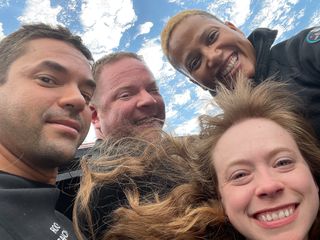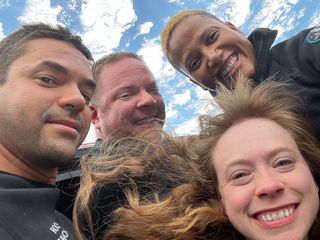Inspiration4 was the world’s first all-civilian orbital mission, sending a four-person crew skyward atop a SpaceX Falcon 9 rocket. The privately funded commercial mission took place from Sept. 16 to Sept. 18, 2021.
Inspiration4 used a SpaceX Crew Dragon spacecraft called “Resilience,” which was commanded by billionaire entrepreneur Jared Isaacman, the founder and CEO of Shift4 Payments. You should get familiar with that name, as he’s also leading the upcoming Polaris Dawn mission, the first effort in the three-flight Polaris program, which is funded and commanded by Isaacman.
Isaacman booked four seats on Resilience. He took one of them, and Sian Proctor was selected to be the mission’s pilot. Isaacman donated the other two seats to St. Jude Children’s Research Hospital in Memphis, as part of a fundraising and awareness campaign. The hospital picked physician assistant Hayley Arceneaux for one seat and held a raffle for the other. The raffle winner gave the seat to his longtime friend Chris Sembroski, filling out the Inspiration4 crew.
Looking out the window
Space.com caught up with Sembroski last month via video link at a pre-grand-opening event for Home Beyond Earth, an impressive and immersive new exhibition at The Museum of Flight in Seattle.
The exhibition focuses on space stations past, present and future. But Sembroski said he felt particularly at home eyeing a huge video display that shows imagery of Earth as seen from space.
Related: Facts about Inspiration4, the first all-civilian spaceflight on SpaceX Dragon
“I keep thinking about how much I want to go back in space,” Sembroski told Space.com. “For me, I did spend time looking out the window back at Earth.”
Those views were particularly stunning on Inspiration4. The mission didn’t meet up with the International Space Station, so the docking adapter that comes standard on Dragon capsules was left on Earth. In its place, Resilience was outfitted with a domed plexiglass window, giving the crew unprecedented views of Earth — and a particularly strong dose of the overview effect.
“Even though I felt physically separated from Earth, I felt more drawn to our planet than I had before,” Sembroski said. “Seeing Earth in that way is a great introduction to the start of an entire novel. It should begin: ‘Welcome to Earth. These are all the amazing, incredible places on this planet. Now go and be amongst that and go connect with it closer.'”
Sembroski said his post-mission goal is to visit what he saw of our home planet from his unique perch in space. “I really want to see the Andes, the incredible deserts, mountains and ocean scenery. I need to go and visit the interior of Australia and visit the great coral reefs down there.”
Medical probing
Inspiration4 also studied the impact of spaceflight on the human body. The crew collected biospecimen samples before, during and after their flight. They also gauged physiological and stress responses, as well as neurovestibular changes during their Earth-circling trek.
Output from that medical probing was published in the journal Nature last month. These results and datasets have been made available as a resource to further biomedical and spaceflight study.
“We were test subjects for all the science and medical experiments that were conducted on our flight,” Sembroski recounted. “What’s unique is that everybody has a chance to know me better than I know myself. All of the medical data that’s been extracted is going to a publicly accessible database — the first of its kind.”
Sembroski did more than conduct biomedical tests and look out the window, however; other tasks were on his to-do list as well.
“I had the title of mission specialist. I was responsible for weight balance and cargo management [of the spacecraft] and its center of gravity for reentry,” he said. “I communicated where things were … very important. I was also the server, handing out all the meals.”

Live up to history
Sembroski was more than ready to take on his space assignment; in some ways, he’d been preparing for it for most of his life. “My brother collected baseball cards [as a kid]. I collected 8×10 glossies of astronauts,” he said.
Sembroski said he was awestruck during the entire mission. But he was also aware of the risks, drawing upon his past tour guide experience at NASA’s Kennedy Space Center in Florida.
“My challenge was to communicate to my wife and family how different things had changed. I told them there’s not that many more things to be worried about. It’s much safer than even the shuttle was. My wife had all the apprehension,” he explained.
The opportunity that the Inspiration4 crew was afforded “means that they have full confidence in the capabilities of the spacecraft,” said Sembroski. “The only anxiety was trying to figure out how I’m going to live up to history. Why am I in this particular seat, after all those people had taken off from the same launch pad … even gone to the moon!”
Related: SpaceX’s Inspiration4 mission opened a new era of private spaceflight
RELATED STORIES:
Sharing the experience
Sembroski still has a foot in the final frontier; he’s now an avionics engineer at Blue Origin, the aerospace company run by Jeff Bezos.
“I’m working on the equipment inside the New Glenn rocket, getting it ready to fly this year,” Sembroski said. “There are so many new things that we’re going to be rolling out at Blue Origin that have been in the works, in the background, for a long time.”
Sembroski is also an adjunct faculty member at Embry-Riddle Aeronautical University. He’s always keen to share his personal, off-Earth experience with students and the public. Indeed, Sembroski said that he’s headed for Space Camp at the U.S. Space and Rocket Center in Huntsville, Alabama, later this summer to detail his adventure.
“The spacesuit I wore in Dragon is on permanent exhibit there,” Sembroski concluded. “I’ll go visit myself.”



